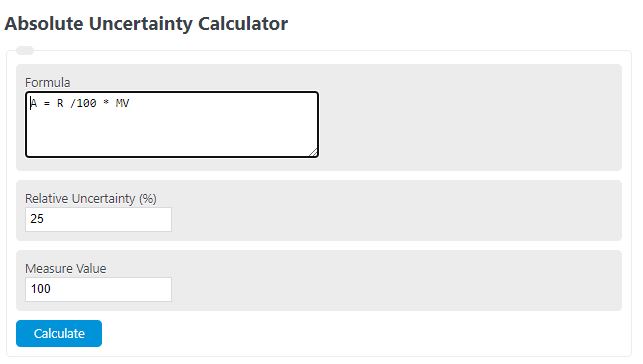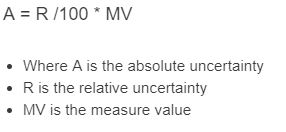Enter the relative uncertainty and the measured value of a data point into the calculator to determine the absolute uncertainty.
Absolute Uncertainty Formula
The following formula is used to calculate absolute uncertainty.
A = R /100 * MV
- Where A is the absolute uncertainty
- R is the relative uncertainty
- MV is the measured value
To calculate absolute uncertainty, divide the relative uncertainty by 100, then multiply by the measured value.
Absolute Uncertainty Definition
An absolute uncertainty is defined as the total uncertainty of a data set based on the relative uncertainty and a measured value.
Absolute Uncertainty Example
How to calculate absolute uncertainty?
- First, determine the relative uncertainty.
Calculate the relative uncertainty.
- Next, determine the measured value.
Calculate the measure or reported value.
- Finally, calculate the absolute uncertainty.
Calculate the absolute uncertainty using the formula above.
FAQ
How do you calculate relative uncertainty?
Relative uncertainty can be calculated by dividing the absolute uncertainty by the measured value, then multiplying the result by 100 to get it in percentage form.
Why is it important to calculate absolute uncertainty?
Calculating absolute uncertainty is crucial in scientific measurements as it provides a quantitative measure of the precision of an experiment or measurement, indicating how much the measured value could vary.
Can absolute uncertainty be negative?
No, absolute uncertainty cannot be negative. Uncertainty represents a range of possible values around a measurement and is always a positive quantity.
How does the measured value affect the absolute uncertainty?
The measured value directly affects the absolute uncertainty since the absolute uncertainty is calculated by multiplying the relative uncertainty (a percentage) by the measured value. A larger measured value with the same relative uncertainty will result in a larger absolute uncertainty.

